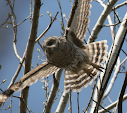
Check the bright orange color on the underside of the tail. That is a tell-tale indicator for the Baltimore Oriole. I had to double check that one, because later in the morning when I stopped at the picnic grounds at Jumbo Reservoir I had the pleasure of seeing a large group of Orchard Orioles widely scattered with the Western Kingbirds throughout the trees.
Both species have dark heads, with the most prominent difference being the more red-orange color of the Orchard Oriole. However, since I had seen the brilliant orange of the Baltimore at sunrise, and was watching the darker orange Orchards in the broken shade of the grove of trees I wanted some other field mark to make sure I had both species and wasn't just trying to make one species into two. The clincher was the underside of the tail. On the Baltimore, the already mentioned orange is visible, but the Orchard Oriole's tail is all black. That makes the tail a good reference point when lighting and time of day make comparing the two species by color more difficult. Another difference between the two is size, with the Orchard averaging smaller than the Baltimore Oriole. I did get a feel for the smaller size of the Orchard Oriole while I was in the field, and before I had consulted the guide back at my truck. I even had one pose close to a Western Kingbird for a comparison shot.

As I was leaving I got an unexpected look at a juvenile Orchard Oriole. I was surprised that the yellow bird with a black throat would turn into a chestnut bird with a black head, but then if a bright orange fuzzball can turn into a sleek black American Coot I guess nothing is really that surprising.

As I was leaving I got an unexpected look at a juvenile Orchard Oriole. I was surprised that the yellow bird with a black throat would turn into a chestnut bird with a black head, but then if a bright orange fuzzball can turn into a sleek black American Coot I guess nothing is really that surprising.




No comments:
Post a Comment